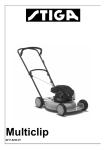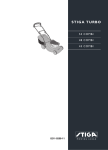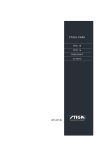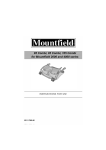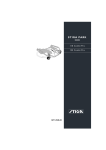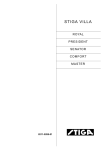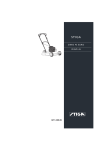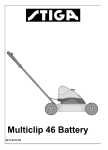Download Stiga GARDEN 8211-0202-11 User's Manual
Transcript
STIGA GARDEN COMBI MULTICLIP 8211-0202-11 H I 1. 5. - + 6. 2. D 3. 7. G C 4. 8. G 9. 13. 10. 14. N M 11. 15. 12. 16. 17. 5 2 3 6 7 1 18. 3 4 19. 3. GB ENGLISH GENERAL This symbol indicates WARNING. Personal injury and/or damage to property may result if the instructions are not followed carefully. SYMBOLS The following symbols can be found on the machine to remind you of the care and attention that are required during use: The symbols mean: Warning! Read the instruction manual and the safety manual before using the machine. Shim washer Locking nut Wing nut Washer Battery mount 16 x 38 x 1.0 8.4 x 24 x 2.0 STEERING WHEEL Install the wheel on the steering column with the enclosed pin and push on the steering column sleeve. The shim washers in the accessories bag should be installed between the lower and upper steering column jacket to compensate for any axial play: 0, 1 or 2 washers may be necessary (fig. 1). BATTERY Warning! Do not insert your hands or feet under the cover when the machine is in operation. The battery is a valve-regulated battery with 12 V nominal voltage. The battery is maintenance-free insofar as you don’t have to check or top up the electrolyte level. Warning! Watch out for discarded objects. Keep onlookers away. On delivery, the battery is in the accessories box. Warning! Before starting repair work, remove the spark plug cable from the spark plug. Warning! Use hearing protectors. Warning! This machine is not designed to be driven on public roads. INSTALLATION To avoid injury and damage to people and property, try not to start the engine before all the measures under “ASSEMBLY“ have been carried out. ACCESSORIES BAG A plastic bag is enclosed with the machine containing: No. 1 1 1 1 2 2 2 1 Designation Dimension Spark plug sleeve Torsion pin for ditto Shim washer 16 x 38 x 0.5 The battery must be fully charged before being used for the first time. The battery should always be stored fully charged. If the battery is stored for longer than 10 days without being charged, it can be damaged. If the machine is not going to be used for an extended period (more than 1 month), the battery should be charged, disconnected and then stored in a cool, safe place. Charge the battery completely before reinstalling. The battery can be charged in two ways: 1. Via a battery charger (recommended). This must be a charger with constant voltage. The battery can be damaged if a standard type battery charger (for acid batteries) is used. Stiga recommends battery charger with item no. 1136-0602-01 which may be ordered by an authorised dealer. 2. You can also allow the engine to charge the battery. In this case it is very important, above all when starting the machine for the first time and when it has not been used for a long time, to allow the engine to run continuously for at least 45 minutes. GB ENGLISH Do not short circuit the battery’s terminals. Sparks occur which can result in fire. Do not wear metal jewellery which can come into contact with the battery terminals. In the event of damage to the battery casing, cover, terminals or interference to the strip covering the valves, the battery should be replaced. If the battery terminals are coated with oxide, they should be cleaned. Clean the battery terminals with a wire brush and grease them. Position the battery in the appropriate place under the engine casing and thread over the battery mount in accordance with fig. 2. Press down the mount into the appropriate holes. Place the locking nuts in the wing nuts. Thread the washers onto the battery mount’s legs from below and secure with the wing nuts so that the battery is securely mounted. Connect the battery cables. NOTE! To avoid damage to the engine and the battery, the positive battery cable (+) should always be connected to the battery first. 4. Install the battery cables. GRASS COLLECTOR (Accessory) Assemble the grass collector according to the separate assembly instructions supplied with the grass collector. The ejector tube G may only be used together with the complete grass collector. When using the grass collector, all components which make up the collector must be installed on the machine (fig. 5). Never use the machine without the collection sack H and the long ejector tube being installed. There is a risk of stones and other objects being thrown out, injuring people and animals or damaging property. Warning for the rotating blade. Never put your hand or foot in the ejector opening. CONTROLS Do not run the engine when the battery is disconnected. Items 1 - 7, see figures 18 - 19. TYRE PRESSURE 1. HEIGHT SETTING LEVER Check the air pressure in the tyres. Correct air pressure: Front: 1.7 bar (24 psi) Rear: 0.6 bar (9 psi) Lever for setting the height of the cutting deck above the ground. CUTTING DECK Release the lever by pushing it inwards. Then move it up or down to the desired position. The deck’s parallel alignment with the surface can be adjusted with nuts D at the rear deck suspension mounts (fig. 3). The lever has five positions, giving cutting heights from 35 to 75 mm. Multiclip (Garden Multiclip - Garden Combi): The unit is installed on the machine on delivery. Lever for engaging the drive for the cutting deck. There are two positions: Collector (Garden Combi): The unit is installed on the machine on delivery but must be completed with ejector tubes. 2. BLADE ENGAGING LEVER 1. Lever in the forward position – the blade rotates. 1. Disconnect the battery cables. 2. Remove the cover C (fig. 4). 3. Install the ejector tube G (fig. 4). Use the same screws and nuts as were used for the cover. Under no circumstances may the lawnmower be started if the cover has not been replaced with the ejector tube. 2. Lever in the rear position – the blade does not rotate. The blade brake is activated. 3. SERVICE BRAKE/CLUTCH A pedal that combines both service brake and clutch. There are 3 positions: GB ENGLISH 1. Pedal released – forward drive engaged. The machine will move if a gear is engaged. Service brake not activated. once again. Engage the gear once again. Never force a gear in. 2. Pedal depressed halfway – forward drive disengaged, gear shifting can be performed. Service brake not activated. Ignition lock used for starting/stopping the engine. There are 3 positions: 3. Pedal fully depressed – forward drive disengaged. Service brake fully activated. 2. Operating position (no symbol). 4. PARKING BRAKE An inhibitor that can lock the brake pedal in the depressed position. Depress the brake pedal fully. Move the brake inhibitor to the side and then release the brake pedal. The parking brake is released by gently pressing the brake pedal. The spring-loaded inhibitor slides to one side. 7. STARTER KEY STOP START- 1. Stop position – the engine is shortcircuited. The key can be removed. 3. Start position – the electric start motor is activated when the key is turned to the spring-loaded start position. Once the engine has started, let the key return to operating position. USING THE MOWER AREAS OF USE The machine may only be used for the following tasks using the genuine STIGA accessories stated. Make sure that the parking brake is released when operating the machine. 1. Mowing 5. THROTTLE/CHOKE CONTROL 2. Grass clipping and leaf collection A control for setting the engine speed and to choke the engine when starting from cold Idling. Full throttle – when the machine is in operation, full throttle should always be used. Full throttle located 1 - 1.5 cm from the bottom edge of the groove. Choke – for starting a cold engine. The choke is located in the bottom of the groove. 6. GEAR LEVER A lever for selecting one of the five forward gears in the gearbox (1 - 2 - 3 - 4 - 5), neutral (N) or reverse (R). The clutch pedal (on the left-hand side of the machine) must be depressed when changing gear. NOTE! You must make sure the machine is quite stationary before changing from reverse to forward gear or vice versa. If a gear does not engage immediately, release the clutch pedal and then press it in With the cutting deck mounted originally. Using towed collector 13-1978 (30“). 3. Grass and leaf transport Using dump cart 13-1979 (Standard) or combi cart 13-1992 (plastic). The maximum vertical load on the towing hitch must not exceed 100 N. The maximum over-run load on the towing hitch from towed accessories must not exceed 500 N. NOTE! Before using a trailer, contact your insurance company. NOTE! This machine is not intended to be driven on public roads. BEFORE STARTING You must read these instructions for use and the accompanying pamphlet “SAFETY INSTRUCTIONS“ carefully, before starting up the machine. SAFETY SYSTEM This machine is equipped with a safety system that consists of: GB ENGLISH - a switch on the gearbox a switch in the seat mount a switch at the blade engaging lever a replaceable, electronic safety module which controls the system In order to start the machine, the following are necessary: - the gear lever in neutral - driver sitting on seat - the blade engaging lever in the rear position (= blade disengaged) Always check the operation of the safety system before using the machine! Check as follows: - start the engine, sit on the seat, engage a gear, lift your weight off the seat – the engine should stop. - start the engine again, sit on the seat, engage the blade, lift your weight off the seat – the engine should stop. Do not use the machine if the safety system is not working! Take the machine to a service workshop for inspection! FILL UP THE PETROL TANK Always use lead-free petrol. You must never use 2-stroke petrol mixed with oil. NOTE! Bear in mind that ordinary lead-free petrol is a perishable; do not purchase more petrol than can be used within thirty days. Environmentally friendly petrol can be used, i.e. alkylate petrol. This type of petrol has a composition that is less harmful for people and nature. Petrol is highly inflammable. Always store petrol in containers that are made especially for this purpose. Only fill or top up with petrol outdoors, and never smoke when filling or topping up. Fill with petrol before starting the engine. Never remove the filler cap or fill with petrol while the engine is running or still warm. CHECK THE ENGINE’S OIL LEVEL On delivery, the engine’s crankcase is filled with SAE 30 oil. Check the oil level every time before using. The machine should be standing on level ground. Remove dipstick B and wipe it off. Slide it down completely and tighten it. Then unscrew it and pull it up again. Read off the oil level. Top up with oil to the “FULL“ mark, if the oil level comes below it (figs. 11 - 12). STARTING THE ENGINE 1. Open the fuel cock. 2. Make sure that the sparking plug cable is properly in place. 3. Make sure that the cutting deck is disengaged. The blade engaging lever should be in its rear position. 4. Put the gear lever in neutral. 5. Starting cold engine – put the throttle control in the choke position. Starting warm engine – put the throttle control at full throttle (1 - 1.5 cm above the choke position). 6. Depress the brake pedal fully. 7. Turn the starter key and start the engine. 8. Once the engine has started, move the throttle control gradually to full throttle if the choke has been used. 9. When starting from cold, do not make the machine work under load immediately, but let the engine run for a few minutes first. This will allow the oil to warm up. STOPPING Move the blade engaging lever backwards to the disengaged position. Apply the parking brake. Allow the engine to idle 1 - 2 mins. Stop the engine by turning off the starter key. Then remove the starter key. Shut off the petrol cock. If the machine is left unattended, remove the spark plug cable from the spark plug. The engine may be very warm immediately after it is shut off. Do not touch the silencer, cylinder or cooling fins. This can cause burn injuries. GB ENGLISH CUTTING TIPS Before mowing the lawn, take care to remove any loose stones, toys and other hard objects. Locate any fixed objects before mowing a lawn you are unfamiliar with. Loose and/or fixed objects can seriously damage the cutting deck. Do not cut wet grass (during or immediately after rain). Keep hands and feet away from the rotating blade. Never put your hand or foot under the blade casing or in the grass ejector while the engine is running. If the engine has stopped due to the grass being too thick: disengage the cutting deck and move the machine to a cut area before engaging it again. MAINTENANCE No servicing may be carried out on the engine or cutting deck unless: -the engine has stopped. -the starter key has been removed. -the spark plug cable has been removed from the spark plug. -the parking brake has been applied. -the cutting deck is disengaged. MAINTENANCE TIPS The machine is designed to stand on its end during maintenance work (fig. 7). If the machine is to stand on its end, the petrol and engine oil must have been drained out first. For optimum ‘Multiclip effect’, follow these tips: - cut frequently. - run the engine at full revs. - keep the underside of the cutting deck clean. - use sharp blades. - do not cut wet grass. - cut twice (with different cutting heights) if the grass is long. CLEANING OPERATION Change the oil the first time after 5 hours of operation, and subsequently every 50 hours of operation or once a season. Change oil when the engine is warm. Make sure that there is the correct quantity of oil in the engine when mowing on slopes (oil level on “FULL“). Be careful when driving on slopes. No sudden starting or stopping when moving up or down a slope. Never cut across a slope. Move from the top down, and from the bottom to the top. The machine, equipped with original accessories, may not be driven on slopes greater than 10º in any direction. Reduce the speed on slopes and when making sharp turns to prevent the machine from tipping over or you losing control of the machine. Rinse clean the underside of the cutting deck with the garden hose. NOTE! Do not aim the jet directly at the transmission or the air filter. OIL CHANGE, ENGINE Always use a good grade of oil (service grade SF, SG or SH). The engine oil may be very warm if it is drained off directly after the engine is shut off. Therefore, allow the engine to cool a few minutes before draining the oil. 1. Tilt the machine to the left (machine viewed from the rear). Unscrew the oil drain plug J (fig. 8). Let the oil run out into a collection vessel. Do not allow oil to get on the V-belts. Screw in the oil plug. 2. Remove the dipstick and fill up with new oil. Oil capacity: 1.4 litres Oil type, summer: SAE-30 (SAE 10W-30 can also be used. However, oil consumption may increase somewhat if 10W-30 is used. Therefore, check the oil level more regularly if you use this type of oil). ENGLISH Oil type, winter: SAE 5W-30 (if this oil is not available, use SAE 10W-30). Use oil without any additives. Do not fill with too much oil. This can cause the engine to overheat. Check the oil level each time after filling. The level should be at “FULL“. LUBRICATION The front axle has four lubrication points K (fig. 9). Fill with grease (use a grease gun) once per season. Lubricate the steering pinions L with grease a couple of times per season (fig. 10). GB KEEP THE ENGINE CLEAN The engine is air-cooled. A blocked cooling system can damage the engine. Clean the cylinder’s cooling fins and air intake of grass and dirt every 5 hours or daily (fig. 12). This is particularly important when mowing dry grass. Also clean around the silencer to avoid fire. Use compressed air or a brush for cleaning. Do not point jets of water directly at the engine. When cutting dry grass for an extended period of time, the engine’s interior cooling fins may need to be cleaned. Contact an authorised service station. SPARK PLUG Also lubricate the machine’s other moving parts a couple of times per season. Check and clean the spark plug every 100 hours of operation. AIR FILTER Clean the spark plug with a wire brush (not sand blasting) and reset the spark gap to 0.75 mm. Important! Never run the engine without the air cleaner being installed. Foam filter (pre-filter): Clean every 3 months or after every 25 hours of operation, whichever comes first. Paper filter: Replace annually or after 100 hours of operation. More often if the machine works under extremely dusty conditions. Replace the spark plug if the electrodes are excessively burnt. For replacing a spark plug, a spark plug sleeve and a torsion pin are provided in the accessories bag. The engine manufacturer recommends: Champion J19LM or similar. CARBURETTOR 1. Remove the air filter’s protective cover and foam filter (fig. 11). The carburettor is correctly set at the factory and no adjustment is normally required. 2. Wash the pre-filter M in liquid detergent and water. Squeeze dry. Pour a little oil on the filter and squeeze in the oil. If the carburettor does need adjustment, contact a service station. 3. Lift out the paper filter N and clean the air filter housing carefully to prevent dirt getting into the carburettor. 4. Clean the paper filter insert as follows: Knock it lightly against a flat surface. If the filter is very dirty, change it. 5. Assemble in the reverse order. Petroleum-based solvents may not be used when cleaning the paper filter. These solvents can destroy the filter. Do not use compressed air for cleaning the paper filter insert. The paper filter insert must not be oiled. ADJUSTING CLUTCH/BRAKE If the drive belt slips (it can stretch slightly when it becomes worn), there is an adjustment on the gearshift/brake linkage. Adjustment: Move the locking pin O to the rear hole (fig. 13). The brakes are adjusted with nut P on the brake arm (fig. 13). After adjusting, make sure that the clutch is always activated before the brake. REMOVING THE CUTTING DECK 1. Apply the parking brake. 2. Lift the machine and stand it on its end. GB ENGLISH If the machine is to stand on its end, the petrol and engine oil must have been drained out first. 3. Set the lowest cutting height and remove the locking pin Q (fig. 14). 4. Remove the two rear locking pins R and the cables for the switch contact on the deck (fig. 15). 5. Force the belt off the pulley (bend the belt guide S upwards) (fig. 16). 6. Lift off the deck. REPLACING V-BELT ENGINE - CUTTING DECK 1. Remove the cutting deck (see above). 2. Remove the belt loop T. Remove the old belt (fig. 17). 3. Tighten screw and nut. Replace the brake lining when it is worn. BLADE Ensure that the blade is always sharp. This produces the best cutting results. SHARPENING For safety reasons, the blade should not be sharpened on an emery wheel. Incorrect sharpening (= too high temperature) could cause the blade to become brittle. Sharpening of the blades must be done by wet method grinding, using a whetstone or a grindstone. Once the blade has been sharpened, it must then be balanced to avoid vibration damage. 3. Install a new genuine belt in reverse order. REPLACING V-BELT ENGINE - TRANSMISSION 1. Apply the parking brake. 2. Lift the machine and stand it on its end. If the machine is to stand on its end, the petrol and engine oil must have been drained out first. 3. Remove the cutting deck (see above). 4. Undo spring U and remove the belt idler V (fig. 16). 5. Disconnect the belt guide X and turn it to one side. 6. Force the defective belt over the transmission’s belt pulley. Work from the machine’s upper side. Use the hole in the base plate. 7. Force the belt over the engine belt pulley. Bend down the belt guide S and place the belt in the lower groove. Bend up the belt guide and remove the defective belt. REPLACING THE BLADE When replacing the blade, blade holder and blade screw – always use genuine spare parts. Always use original spare parts. Nongenuine spare parts can entail a risk of injury, even if they fit the machine. When replacing the blade, the centre bolt should also be replaced. This is equipped with a lock. Blade screw tightening torque: 65 Nm. SPARE PARTS STIGA genuine spare parts and accessories are designed specifically for STIGA machines. Please note that ‘non-genuine’ spare parts and accessories have not been checked or approved by STIGA. The use of such parts and accessories can affect the function and safety of the machine. STIGA accepts no responsibility for damage or injuries caused by such products. 8. Install a new genuine belt in reverse order. ADJUSTING BLADE BRAKE 1. Set the blade engaging lever in the rear, disengaged position. 2. Undo the blade brake Y and adjust so that it is lying flush with the belt pulley (fig. 17). STIGA reserves the right to make alterations to the product without prior notification. MOWING AHEAD Box 1006 · SE-573 28 TRANÅS w w w. s t i g a . c o m













